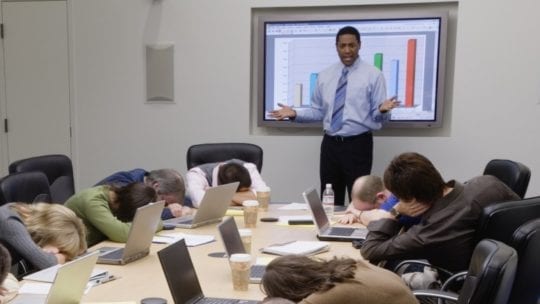
Who among us hasn’t had the calendar alarm go off and been filled with existential dread? Meetings, while necessary, can often drain employees, waste time and leave participants feeling bored.
Skip Weisman recognizes that mentality and is trying to change it.
“The thing that gets in the way is, people just don’t invest the time in meetings to make them work effectively,” said Weisman, an expert, consultant, public speaker and author on the culture of businesses. People see meetings as a waste of time and that might be because of how historically bad they’ve been. They go in with a preconceived notion.”
It's time to shake up the model and make your meetings more productive—even exciting. Here are five ideas to help.
Set a concrete purpose and curated list of attendees. “Everything is really driven from the purpose of the meeting. Why are we meeting?” Weisman says. “If you don’t start with that underlying premise, that’s a problem. How many times have you been in a meeting where after a few minutes you think ‘why am I here?’”
Weisman said he understands meetings are sometimes viewed as social occasions, and leaving some employees out might be viewed negatively. That’s why the purpose of the meeting needs to be clearly defined. “Think of it this way,” he said. “If you’re the Patriots and you’re focusing on the Rams’ defense, you don’t need (quarterback) Tom Brady in that meeting.”
Weisman said having the right people in the right meeting depends on the topic, of which there are defined types of meetings. They include: Information Gathering (managers gathering info from employees); Information Distribution (there’s something going on in the organization, and here’s who needs to know about it); Planning (a big event is coming up and here’s who we need to help run it); Decision-Making (who are the pertinent people to add value to making a decision?); Problem-Solving (who are the best people to solve a problem?); Brainstorm/Feedback (let’s get all the ideas we can); Lessons Learned (a review of what worked and what didn’t); and Icebreaking/Team Building (just getting everybody together).
Choose a good location. Joseph Lanzisera says one of the new trends is “agile business,” or the concept accomplishing tasks with more agility. That includes meetings.
“You’re looking to be quick but to be high impact,” says Lanzisera, principle at the 60-person technology and business consultancy Eigen X, located in suburban Philadelphia.
Lanzisera said many businesses are going to what are known as “agile daily standups.”
“Each morning, everybody gets together in an agile standup, they go around the room and people talk about what’s on their plate and any obstacles they might encounter,” he said. “The meeting, on purpose, is kept to a very tight timetable and the reason it’s called a standup is because most times it’s held in a room without chairs. We’ve found that going into a room without chairs doesn’t allow people to get lethargic. In fact, many meetings are being held in open spaces—an atrium, a cafeteria—to keep it more informal. The last thing you want is for a meeting to get unwieldy.”
You can also surprise employees by taking the meeting off-site, to a bowling alley or ice cream parlor, for example. This can shake things up in a way that builds camaraderie and stokes energy.
Encourage participation. One trick to encourage interaction is to reward those who ask or answer questions. You could simply bring a bag of chocolates or other small candies to the meeting and toss a piece to each audience member who joins in. Even audience members who don't like candy will often want to be part of the fun. Another tactic is to gamify the experience—adding a game component that keeps meeting-goers engaged and also rewards participation.
Delegate responsibility. Once you determine who should be in the meeting, you have to do something beyond just sending an invite.
“Everybody in the meeting should have a responsibility in the meeting,” Weisman says. “You tell them, ‘I’d like for you to contribute X,’ and give them a role and let them know there is an expectation they’re going to contribute. You have to set people up for success in the meeting. I’m a big believer in giving people assignments for meetings.”
Keep it short. The deadliest sin of a meeting are participants who lack enthusiasm. And the longer the meeting, the more this is likely to become a problem.
“People sort of check out, and there are two solutions,” Weisman said. “One is, command attention. It’s the responsibility of the communicator to command people’s attention by speaking to the audience’s interest and to be succinct. You need to build trust to keep people engaged.”
Weisman said a good example of that is telling employees the meeting will be 45 minutes, and sticking to that.
